Comma Rules for Clear Writing (with Examples)
One of the most commonly used punctuation marks, an errant comma can be the difference between a complete sentence and a complete mess. In this post, we’ll explore seven comma rules that will keep your writing concise and coherent.
Before we dive in, what is a comma anyway? You can think of a comma as a lighter version of a period. While a period ends a sentence full-stop, a comma is a smaller, softer pause. It can separate words, clauses, or ideas within one sentence.
1. Two complete sentences can only be connected with a comma when using a coordinating conjunction.
A coordinating conjunction is a conjunction placed between words, phrases, clauses, or sentences of equal rank. English has seven main coordinating conjunctions — for, and, nor, but, or, yet, so — that can be used to weave together two complete sentences with a comma. You can use the mnemonic FANBOYS to remember them.
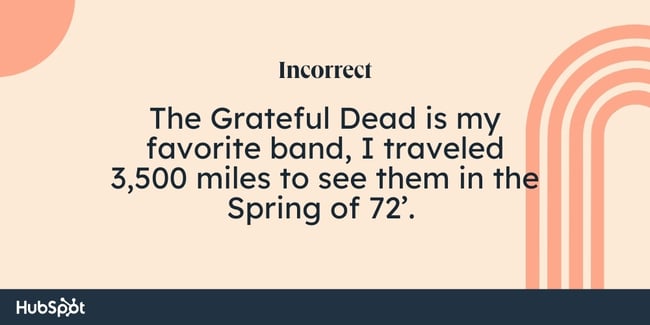 Both of the above thoughts are complete sentences. However, the lack of one of our FANBOYS after the comma results in a comma splice. The sentence is clunky without the presence of a coordinating conjunction to link the two complete thoughts in one sentence.
Both of the above thoughts are complete sentences. However, the lack of one of our FANBOYS after the comma results in a comma splice. The sentence is clunky without the presence of a coordinating conjunction to link the two complete thoughts in one sentence.

That’s more like it! “So” is the coordinating conjunction that links these two complete sentences together. Both thoughts could stand alone separated by a period, but our FANBOYS allow us to link them together with the help of a comma. The Grateful Dead is your favorite band? It makes sense that you traveled so far to see them.
2. Use a comma to link an incomplete sentence with a complete sentence.
An incomplete sentence doesn’t express a fully formed thought and can’t stand on its own. However, you can use a comma to link an incomplete sentence with a fully formed sentence that expounds upon and completes the thought. For example:
 “Even though I had work in the morning” is an incomplete sentence. Ending it with a period makes it into a cliffhanger of an unfinished thought, but a comma can save the day.
“Even though I had work in the morning” is an incomplete sentence. Ending it with a period makes it into a cliffhanger of an unfinished thought, but a comma can save the day.
 The use of a comma and the following complete sentence “I traveled 3,500 miles to see the Grateful Dead in Copenhagen.” make this into a grammatically correct sentence. Something tells me you didn’t make it to work the next day, though!
The use of a comma and the following complete sentence “I traveled 3,500 miles to see the Grateful Dead in Copenhagen.” make this into a grammatically correct sentence. Something tells me you didn’t make it to work the next day, though!
3. Use the Oxford comma.
The Oxford comma is a controversial topic in the world of punctuation. There is great historical debate on whether the Oxford comma is necessary, but we here at HubSpot recommend using it for accuracy and clarity in your writing.
What is the Oxford comma?
The Oxford comma is the final comma in a list of things. For example: I need a stapler, some rye bread, and a gallon of glue.
I don’t know what you could be making, but that’s the proper use of an Oxford comma in a list of items. Here’s another example:

This sentence states that you watched a documentary about three distinct and influential New Yorkers. The Oxford comma makes it clear that these are three different people. If we omit the Oxford comma, things can get a little confusing:
 Unless Babe Ruth lived a secret life of crime and thin-crust pizza, you can see how the absence of the Oxford comma in this sentence could confuse readers. While both versions of the sentence are technically correct, we recommend the Oxford comma to ensure your sentences are free of ambiguity.
Unless Babe Ruth lived a secret life of crime and thin-crust pizza, you can see how the absence of the Oxford comma in this sentence could confuse readers. While both versions of the sentence are technically correct, we recommend the Oxford comma to ensure your sentences are free of ambiguity.
4. Use a comma between two coordinate adjectives that describe the same noun.
Coordinate adjectives are two or more adjectives that describe the same noun. If you flip-flop your adjectives or pop an “and” in between them and the sentence still makes sense, then you’ve got coordinate adjectives. If you’re using coordinate adjectives, remember to separate them with a comma.
 Psychedelic and spontaneous are coordinate adjectives because they together describe the noun, which is the music of the Grateful Dead. You can reverse the order or substitute the comma for an “and” and the sentence means the same thing. We recommend using a comma.
Psychedelic and spontaneous are coordinate adjectives because they together describe the noun, which is the music of the Grateful Dead. You can reverse the order or substitute the comma for an “and” and the sentence means the same thing. We recommend using a comma.
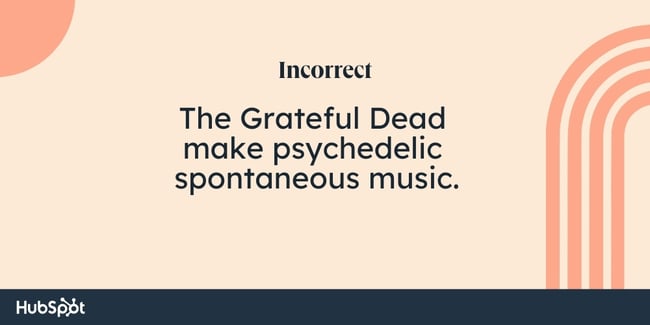
It’s subtle, but the sentence doesn’t flow correctly without a comma between psychedelic and spontaneous.
5. Use a comma (or pair of commas) to separate non-essential information in a sentence.
 Although we appreciate the information, “in a quest for the perfect rack of ribs” is non-essential to the main point of the sentence, which is that my father-in-law spent way too much on his grill. You can use a single comma with the non-essential information at the beginning of the sentence, or a pair of commas to rope it off in the middle, but don’t forget your commas when adding extraneous detail.
Although we appreciate the information, “in a quest for the perfect rack of ribs” is non-essential to the main point of the sentence, which is that my father-in-law spent way too much on his grill. You can use a single comma with the non-essential information at the beginning of the sentence, or a pair of commas to rope it off in the middle, but don’t forget your commas when adding extraneous detail.

Without commas to separate the non-essential information, the sentence is long-winded and grammatically incorrect. I’ll take a pair of commas with those ribs, please!
6. Make sure you place commas correctly when using quotes.
In general, you should use a comma to introduce quotes or dialogue in a sentence.
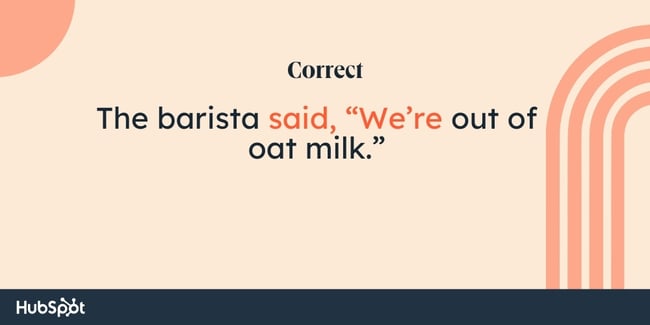
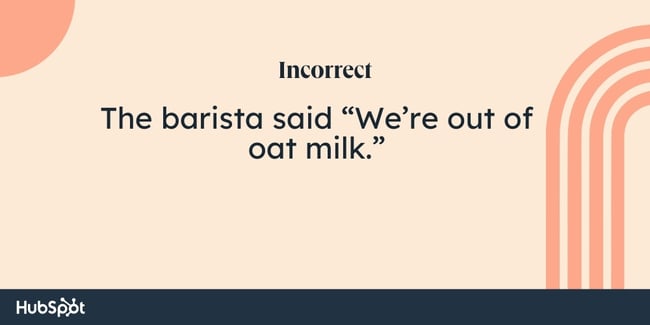
The reason we need a comma in this example is that the quoted material is syntactically independent, meaning it stands apart from the surrounding sentence. Don’t be rude! Introduce that mid-sentence quote with a comma.
However, as there often are in the English language, there are exceptions to this rule. If the quote blends into the surrounding sentence, often with the use of a conjunction, you can omit the comma.
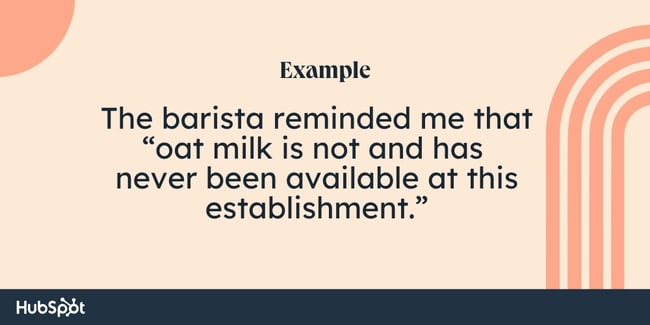 No comma is necessary in this example because the quote blends into the sentence with the use of the conjunction “that.”
No comma is necessary in this example because the quote blends into the sentence with the use of the conjunction “that.”
7. Put a comma before “while” to contrast two ideas.
If you are using “while” in a sentence to essentially mean “although” or “whereas,” remember to place a comma before it to keep the meaning of your sentence clear.
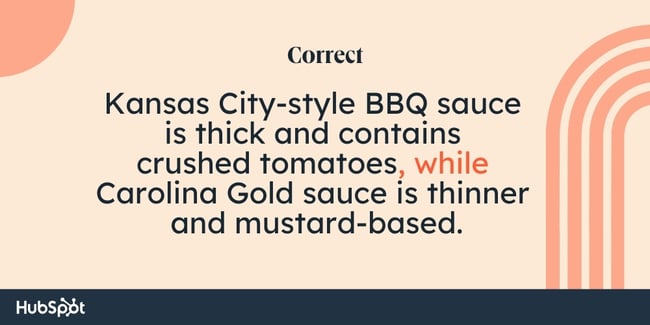
The use of “while” in this sentence allows us to contrast two BBQ ideologies.
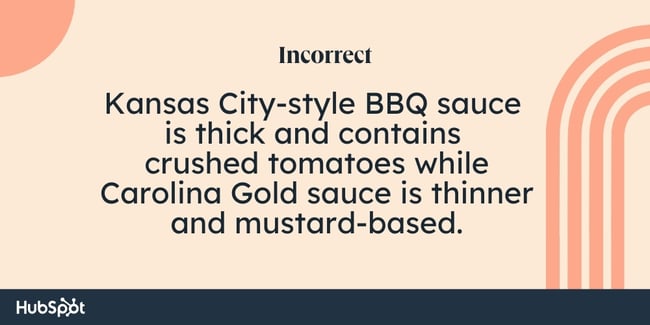
Without the comma, the meaning of while technically changes to “simultaneously,” which doesn’t make sense in this context.
Additionally, if you are using “while” at the beginning of the sentence, you should place a comma at the end of the clause that it introduces.
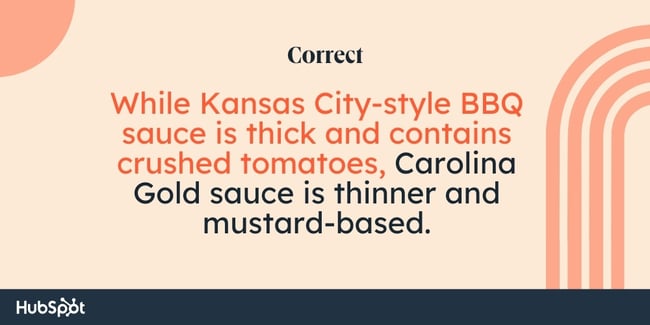
The use of a comma after the clause that “while” introduces allows us to retain the meaning as “whereas” and contrast the two ideas.
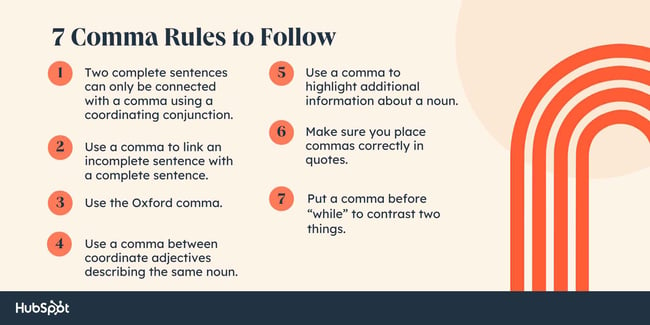
![]()


